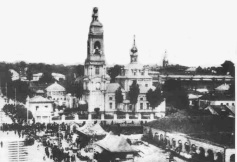
General view of Kursk. The end of the19th century.
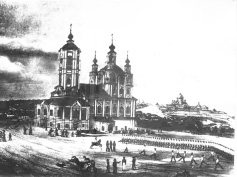
The Spassk gate.
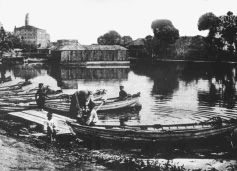
A boat landing-strip on the river Tuskar. The end of the 19 century.
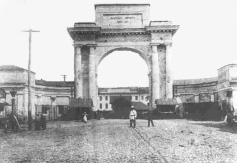
The Moscow gate. 1890 year
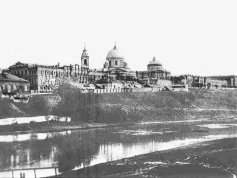
The noble Assembly.The Cloister Znamenskiy. 1912 year.
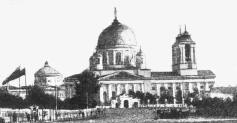
The Cloister Znamenskiy. 1902 year.
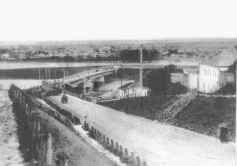
Kursk A way to a district Yamskaya sloboda.
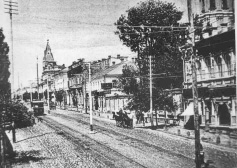
Moscowstreet. 1917 year.
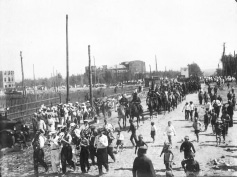
Perekalskiystreet and Pavlovstreet. 1930 year.
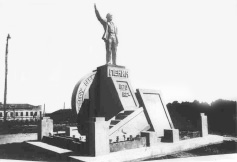
The Lenin Memorial. 1933 year.
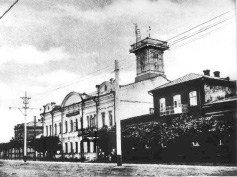
Old Kursk.
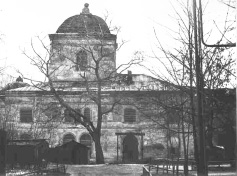
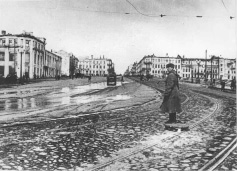
Red square. Leninstreet. 1943 year.
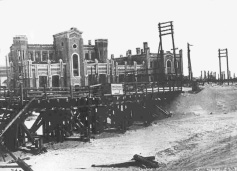
Destroied railway station building. 1943 year.
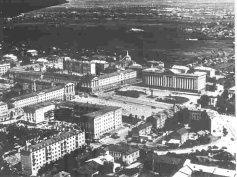
The centre of the town. 1967 year.
Kursk is one of the most ancient Russian towns entered to Kievan Russia at the beginning and then to Moscow State. The first mention of the town is dated by 1032. First people appeared at that region much earlier, thousands years before. The first ancient town appeared in the mouth of the river Kur in the 4th - 5th centuries B.C. It was the first fortress on Kursk land. The evidence of that are the potsherds found at the area of the modern Dom Oficerov building and the factory producing electrical apparatus. The first settlement that appeared before Slavic times existed not for too long. In the 4th Ė 7th centuries of our era, the Slavic did not build any towns. It was only because of the nomadsí attack danger our ancestors moved uphill in the 8th century of our era. Such a way the first Slavic fortress appeared at the cape, formed by the mouth of the river Kur. It was not a large ancient town, surrounded by a ditch and an earthwork. A powerful wall made of a hundred year oaks fortified the earthwork of the town. In the end of the 9th century of our era the region of the river Seim was attacked by the Hazars. In 884, the prince Oleg as a head of the ancient Russian State beat the Hazars. Since that time the Seim region entered the ancient Russian Kievan State. The significance of Kursk rose. In the 10th century, Kursk became a significant fortress according those times. Pottery and smith crafts were developing. Trade developed very quickly, as the town situated at the crossroad of the very important river routes. One of them leaded to Kursk from Kiev along the rivers Dnepr, Desna and Seim. Another one went along the rivers Tuskar and Svapa to Samodurov Lake. Now, that lake does not exist. The third route went upstream the Seim and from there, across the ground (drawing vessels) to the river Seversky Donec, then to the river Don and afterwards to the Azov and Black seas. During the princesí civil discords, Kursk citizens had to defend their town either of the nomads or the fighting each other Russian princesí troops. During that period of time Kursk entered to Chernigov, Pereyaslavl or Suzdal great principality. Bravery of Kursk people was reflected in the ancient Russian legendry ďThe Word of Igorís regimentĒ. At the first quarter of the 13th century, Chingis-han leaded his hordes to the weak of civil discords Russia. A little bit later, in 1237, Batyy moved his uncounted troops to Russia. Such a way the Northern Russia was obeyed, even facing the enemy Russia was not able to unite. However, the enemy got weaker as well. It was not able to take Novgorod, so it turned to the south - east. On its way was Kursk that was completely destroyed by the enemy. In 1355, the basins of the rivers Desna and Seim as well as towns Putivl and Rylsk were obeyed by Litva. In 1508, during the ruling of Moscow prince Vasily the 3rd, Kursk region entered the centralized Russian State and became a border region. In 1597, a military head Ivan Polevoy and a civil head Nelub Ogorev built a fortress, which meant a watershed in the history of the cityís life. The fortress became an organizing center. It had a triangle form, surrounded by a wall with 5 towers. Mostly it was wooden. From the 17th century, the fortress was attacked by the Poles for 4 times (1612, 1616, 1617, 1637). All of the attempts to defeat the town were unsuccessful. The fortress defended itself from the sudden and cheeky Tatarsí attacks. Only in the middle of the 18th century, Kursk fortress lost its military value and disappeared newer being taken by enemy. In 1648-1650, in Russia, there were several town rebellions, in Kursk too. It was not too long, but heavy blast of the civilianís anger in Kursk, which seriously made the government afraid. From Moscow, here, came the troops leaded by the centurion Buturlin. As, a result there was a strict punishment of rebels. In August of 1781, in Kursk, there was heavy fire, destroyed the significant part of the town. In February of 1782, the empress Ekaterina the 2nd approved a new plan of the town that divided town into 4 parts. Their names were Gorodskaya, Zakurnaya (situated by the river Kur), Strelechkaya and Pushkarnaya. The town got a new town planning. At the whole parts of the town districts appeared, they were divided into ďmade of stonesĒ (allowed to build houses only of stones) and ďwoodenĒ (allowed to build wooden houses as well). The districts were divided by straight streets (ulitsi) that amounted together with alleys 182. The most significant of them were ulitsa Moscovskaya (now ulitsa Lenina) and ulitsa Hersonskaya (now ulitsa Dzerginskova). The new town planning caused moving underclass to the cityís outskirts. At the entrance of the town there were built a jail and a number of police watch boxes Ė the symbols of monarchy. In 1782, in Kursk, there were the lettered among merchants - 48%, commoners Ė 26%, women Ė just units. In 1782, in Kursk, there was created Kursk guberniya that had 15 uezds. The territory of Kursk guberniya was 4.6 billions hectares. In June of 1812, Napoleon troops invaded Russia. The enemy went to Moscow. Kursk was not a front-lined town. However, the people of Kursk guberniya made a lot to help the Russian army. If to count all the kinds of charity, collected in Kursk guberniya, they would make 2,000,000 roubles. The whole amount collected in Russia, at that time, was more than 57,000,000 roubles. Beside that help the Russian army, Kursk citizens presented a copy of icon of Holy Motherís Predictive sign to the Head of the Army, M. Kutuzov. That icon helped the citizens of Kursk to defend during the Polish invasion. In 1861, the imperator Aleksandr the 2nd abolished serfdom. The abolition of serfdom leaded to busyness increasing in the economy of Russia. At that time the building widely began, especially railways developed very quickly. One of the first railways was the Moscow-Kursk one (built in 1868). To 1890s, our town became a very important railway center. In 1897, there was tram moving open. The tramsí owners in Kursk were foreigners - the Belgians. During the whole period of reforms there were permanent, peasant irruptions of angry feelings. The worst thing of that was the forcible occupancy of the lands and cutting the landlordsí forests. Sometimes, the peasantís rebellions happened. In the beginning of the 20th century, the guberniya had only 160 factories and 25,000 workers, reprocessing raw produce of agriculture. The biggest part of workers worked at sugerboiling factories (11,000). The other two large factories were a tobacco factory and a manufacture in Glushkovo. The rest factories were small, with no machines used. The exception was the Kursk railway junction. In Kursk, there was a crossroad of two large railways: the Moscow-Kharkov and the Voroneg-Kiev. Kursk took an active part in the revolution of 1905-1907s. In December of 1905, there was a big strike of Kursk and Belgorod railway workers. The strike was suppressed by troops. World War I (1914-1918) became a very trying time for Kursk and its population. The taxes and compulsory supplying for the army increased almost twice as much. A working day increased until 14 hours. Prices got up very high. That is why the news of the monarchy overthrowing was taken with hope. Kursk guberniya wanted peace. In 1918, after the victory of the February Revolution, in Kursk, in the same way as were in the capital of Russia Sankt Petersburg, a diarchy set up. From one side there was Provisional government (bourgeoisie), and from another Ė the Council of workersí and soldiersí deputies (proletariat, peasantry). The Constituent assembly should have made the new powerful structures to avoid the diarchy, however the ďCouncilsĒ took the power unilaterally. In Kursk, the Soviet power was set up without armed rebellion, peacefully on the 26th November of 1917. The setting up of the Soviet power in Kursk guberniya was approved by guberniya Congress I of the Councils on the 24th February of 1918. The October Revolution, unfortunately, did not solve any problems of our State, but created the Civil War (1917 - 1921). The Civil War and World War I went at the same time. All of that caused the Empire break-up. The 3rd March of 1918, the Soviet Russia signed the Brest peaceful agreement with Germany. According that peaceful agreement, Germany got Byelorussia and Ukraine. Kursk guberniya became a boundary one. For the whole time of the Civil War there were continuous counterrevolutionary rebellions of peasants in Kursk guberniya. Such rebellions were against any authorities, because people got tired of war. In 1925-1926, the economic recovery plan began. The old factories rebuilt and reconstructed. Such factories as the machinery factory bearing Kalininís name (now the machine tool plant), the leather processing factory and the yeast-processing factory began working profitably. Factories of light industry and food processing industry worked successfully as well. The prewar production level increased of 33 per cent in 1928. Kursk guberniya got new cultural development after reforming it into Kursk oblast in June of 1934. At the same year, the drama theatre became the oblast drama theatre. There was created a constant theatre troupe. The oblast library, Pedagogical Institute in Kursk (2 faculties, 320 students), Oboyan Library College and 12 pedagogical colleges were created. In the next year, a painting gallery and Medical Institute began working. In 1937, the oblast philharmonic opened. Kursk oblast was the first one in the Soviet Republic where there were no more the illiterate by the beginning of 1939. At the beginning of the century, there had been the littered only 17%, among women 6%. The 22nd of June, Germany invaded the USSR. During the War there were about 500,000 Kursk citizens bounded to the Red Army. The 3rd November of 1941, the Red Army left Kursk, and by the mid of July all the territory of Kursk oblast was occupied by enemy. Numerous echelons with cargo of goods went to Germany. Even famous Kursk black earth was taken to Germany. At the territory of Kursk oblast appeared a strong partisan movement. The Victory in the Stalingrad Battle leaded to the beginning of the Red Army winter offensive. The Victory in the Stalingrad Battle caused the beginning of Kursk oblast relief of German oppression. The 8th of February of 1943, Kursk was freed. The 3rd of March was freed Lgov. The 9th of March, the Soviet troops came to Rylsk. After the March offensive of the Red Army, the frontier at the territory of Kursk oblast took a form of arch that was called The Kursk Arch. Under the German troops, there were only 3 towns left: Rylsk, Krupec and Glushkovo. Russian High Command prepared deep and strong line of defense. The preponderance of force was on Russian side. Just 10 minutes before the German attack that had been planned on the 5th of July at 2.20 a.m., the Red Army launched a heavy artillery bombardment of the German troops. Despite the sustained casualties and the damaged connection with the troops, the Germans launched an operation called ďCitadelĒ. It started in the morning, on the 5th of July, 2.5-3 hours later of the planned time. The 12th of July, the counterattack of the Western and the Briansk fronts began. At that day there was the greatest tank battle in history, at Prochorovka field. There were about 1,200 tanks on both sides. The Germans lost 400 tanks. The attempt of the Germans to take the revanche for the Stalingrad Battle failed at the Kursk Arch. The 5th of August, there were towns Orel and Belgorod freed. In honor of that event Moscow made an artillery salute, the first salute during the war. The 23rd of August, Kharkov was freed. Such a way the battle at the Kursk Arch was finished. During the war 75% of industry was ruined and all of the collective farms. The 1st of November, Kursk was included into the list of the 15th oldest towns needed repairing at first. The aggregate industrial output formed only 26% to the level of 1940. In March of 1946, the factory proceeding electrical apparatus began bringing out its first produce. In the next year, the factory proceeding accumulator batteries began bringing out its first produce as well. The 12th of August of 1952, the new Kursk railway station was open. It was done a lot for iron ore deposit developing in Geleznogorsk area, Kursk loadstone anomalism. The iron ore opencast building was started. The actual output of the iron ore opencast was counted to be 2,500,000 tons a year. In 1953, in the oblast, the transition to the comprehensive 7-year education was completed. In 1959, a TV center and a retranslating station were open. The 1st of September of 1964, Kursk Polytechnic Institute was open. The second part of the 60s was very successful for the economy. So the industry output in Kursk oblast increased by 56%, meanwhile the average value in the USSR was 43%. For the quarter of the century the industry output increased 4.5 times as much. In 1966-1970, there were two factories of the central government built. They are the factory of knitted goods and the chemistry and drug factory. Other factories worked successfully, too. In the end of 1970, the building of a nuclear power station was started (Kurchatov town). Its first electric current, the station produced on the 19th of December of 1976. In 1990, the maximum output of electricity reached 25,000,000,000 kvth a year. In 1991, the economical connections with other republics and regions were lost because of the USSR break-up. The severe economical crisis happened. The total decrease in 1997 was over 50% to the level of 1991. The output of iron ore and electricity were down 20%, the output of accumulate batteries and knitted goods - 10 times as less, building materials Ė 2.5 times as less, milk Ė 7 times as lessÖ Such decrease of the economy was during the German occupation only. A lot of workless appeared. The inflation rose quickly. It is only the present time that the economy of Kursk is being stabilized.
